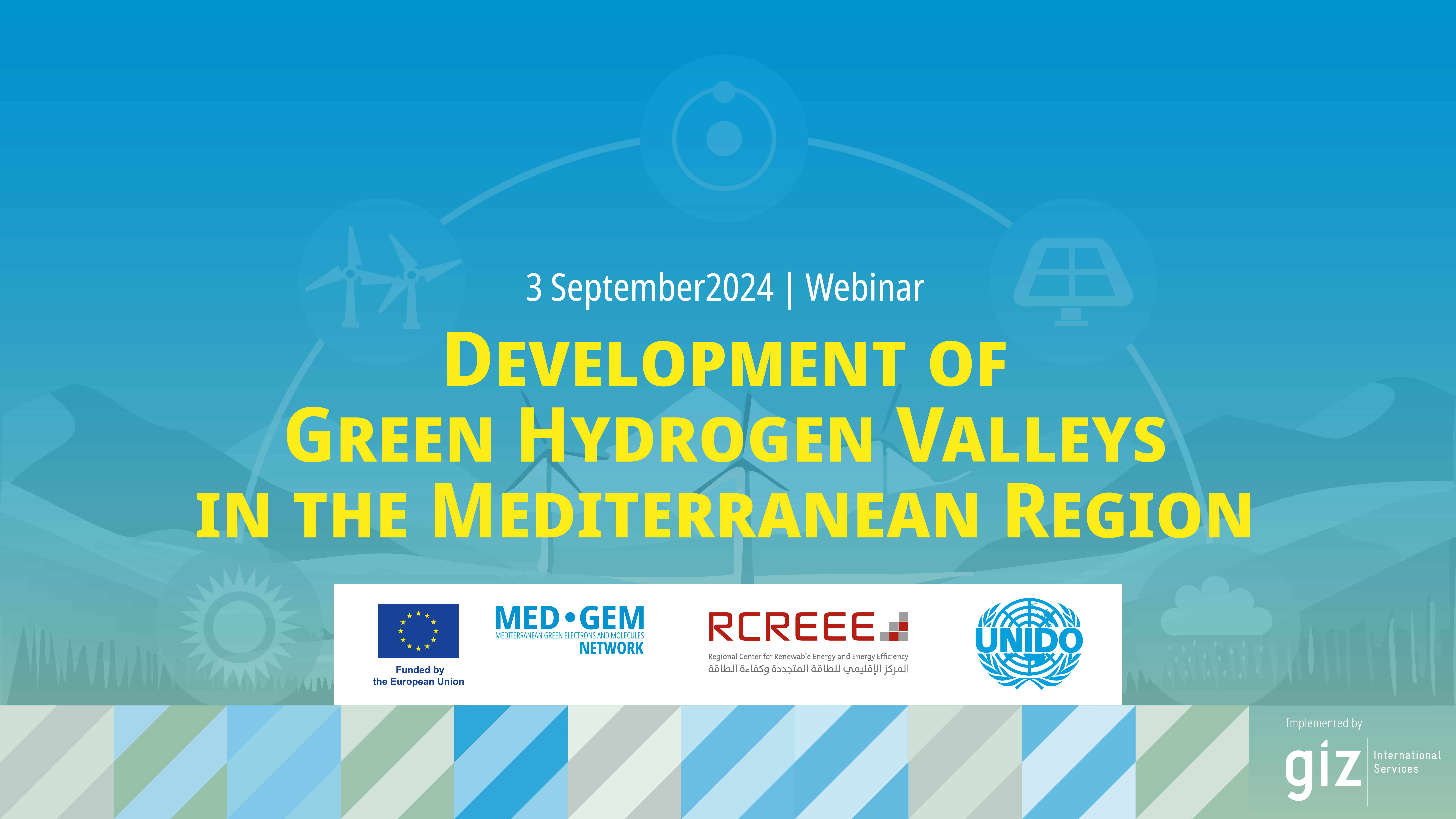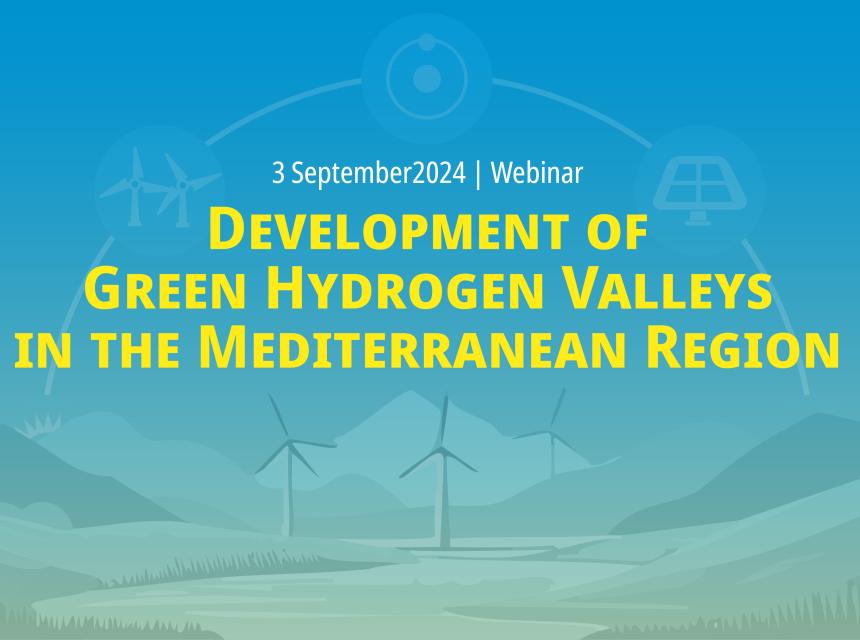Green Hydrogen Valleys: Catalysts for Mediterranean Energy Transition | A UNIDO x RCREEE x MED-GEM Network joint webinar explores the potential of Green Hydrogen Valleys in the Mediterranean Region
The Mediterranean region stands at a pivotal moment in its energy transition, facing the dual challenge of addressing climate change while driving economic growth. In this critical context, the concept of "green hydrogen valleys" represents a visionary framework—integrated ecosystems where renewable energy production, hydrogen generation, and industrial applications align, bolstered by targeted policies, investments, and infrastructure. On September 3, 2024, a pivotal webinar hosted by the EU-funded MED-GEM Network, UNIDO, and RCREEE brought together leading experts to explore the development of these green hydrogen valleys across the Mediterranean. This landmark event offered a vital forum to delve into the transformative potential and the complex challenges associated with this promising technology.

🎬 Watch the webinar / 🔈 Listen as a podcast
Opening Remarks
Frank Wouters, Director of MED-GEM Network, set the tone for the webinar by emphasizing the crucial role of collaboration among MED-GEM, UNIDO, and RCREEE. Wouters described MED-GEM as a “network of networks” aimed at harmonizing efforts between the European Union and Mediterranean countries to advance green hydrogen technology, which is essential for future decarbonization.
Dr. Jauad El Kharraz, Executive Director of RCREEE, highlighted the objectives of green hydrogen valleys, noting their role in promoting the use of hydrogen from renewable sources, developing local infrastructure, and driving economic growth while reducing carbon emissions.
Session 1: Understanding Green Hydrogen Valleys
Moderated by Mustapha Taoumi of MED-GEM, the first session delved into the concept of green hydrogen valleys.
Bart Biebuyck, CEO of Green Energy Park Global, presented the valleys as integrated ecosystems where hydrogen production, storage, and utilization are coordinated. He detailed the evolution of this concept from its inception in 2016, noting its potential to spur local economic growth and job creation. Biebuyck highlighted three initial models of valleys — localized, industrial, and international — and their evolution towards more diversified models.
- 📖 Read the keynote: “Defining Green Hydrogen Valleys and their Importance”
Patrick Cnubben, CEO of Hydrogen Architects, discussed the advantages of hydrogen valleys for various sectors, including transportation and heavy industry. He cited projects like "Heaven" in the Netherlands and initiatives in Greece, Israel, Cyprus, and Turkey, emphasizing the need for cooperation and knowledge sharing.
- 📖 Read the keynote: “Benefits and potential applications of Green Hydrogen Valleys”
The subsequent Q&A session addressed crucial issues such as the necessary policies, regulations, and risks associated with hydrogen projects. Experts underscored the importance of governmental support and international collaboration.
Session 2: Case Studies and Best Practices
Moderated by Luis Umanzor Hernandez of UNIDO, this session featured case studies and best practices.
Jakob Hebsgaard Mogensen from GreenLab in Denmark showcased their model of integrating renewable energy and supporting a circular economy. The GreenLab park uses wind and solar energy for various industrial processes and explores hydrogen value chains.
- 📖 Read the Keynote : “Industry clusters as a green transition accelerator”
Xola Sithole, CEO of the Vaal Special Economic Zone in South Africa, outlined the zone’s ambitions to become a major hub for green hydrogen, attracting investments in clean technologies and reducing the carbon intensity of its operations. These presentations illustrated how local initiatives can act as catalysts for global energy transition, creating sustainable development models.
- 📖 Read the Keynote: “The case of Vaal SEZ”
Session 3: Opportunities and Challenges in the Mediterranean Region
Moderated by Jauad El Kharraz of RCREEE, the final session explored regional opportunities and challenges.
Alberto Giaconia from ENEA discussed Italy’s hydrogen demo valley, emphasizing its role in technology demonstration and market transition.
Sanae El Amrani, Director of Ports and Maritime Public Domains in Morocco, addressed infrastructure challenges for supporting hydrogen production and export, including significant investments in port facilities.
- 📖 Read the Keynote : “Infrastructure challenges in the development of green hydrogen valleys”
Dr. Abdullah Al Abri, VP of Sustainability at Sohar Port and Freezone in Oman, presented Oman’s strategy to become a key player in green hydrogen production, with ambitious production goals and a central role for the Sohar port in establishing sustainable supply chains.
Conclusion:
The webinar concluded with reflections on how these initiatives can drive sustainable development, economic growth, and job creation in their respective regions. The discussions highlighted the potential of green hydrogen valleys to transform the Mediterranean energy landscape, offering a blueprint for a cleaner and more resilient energy future.

